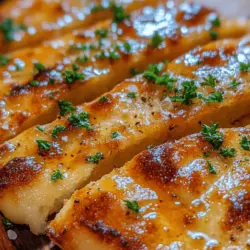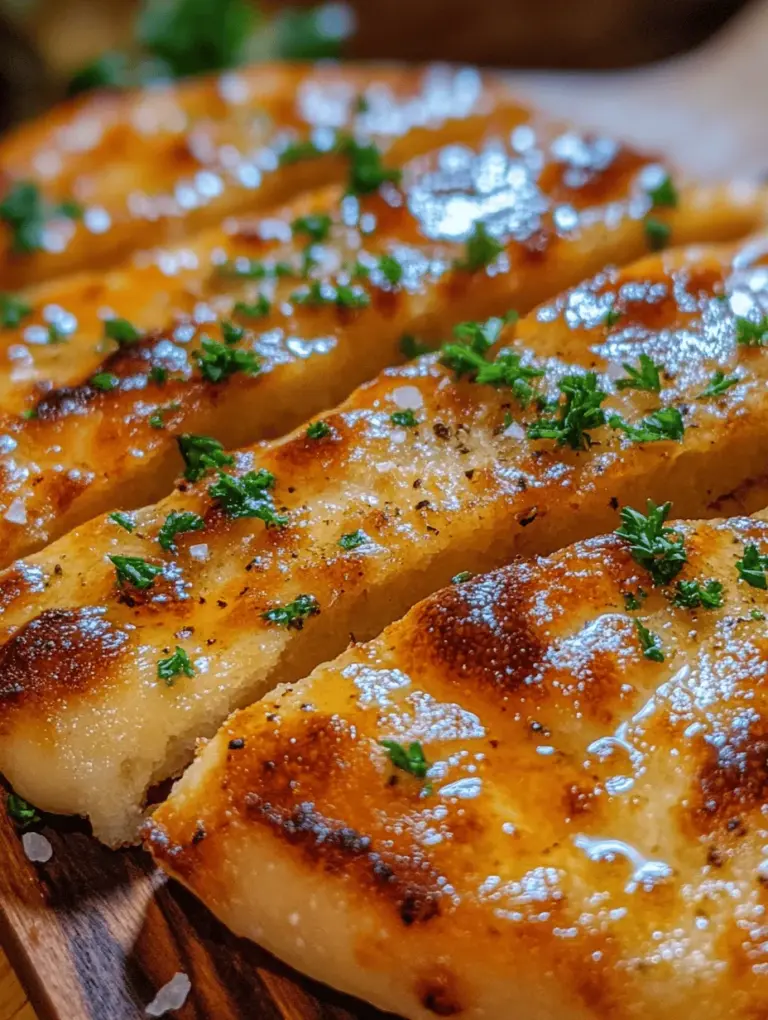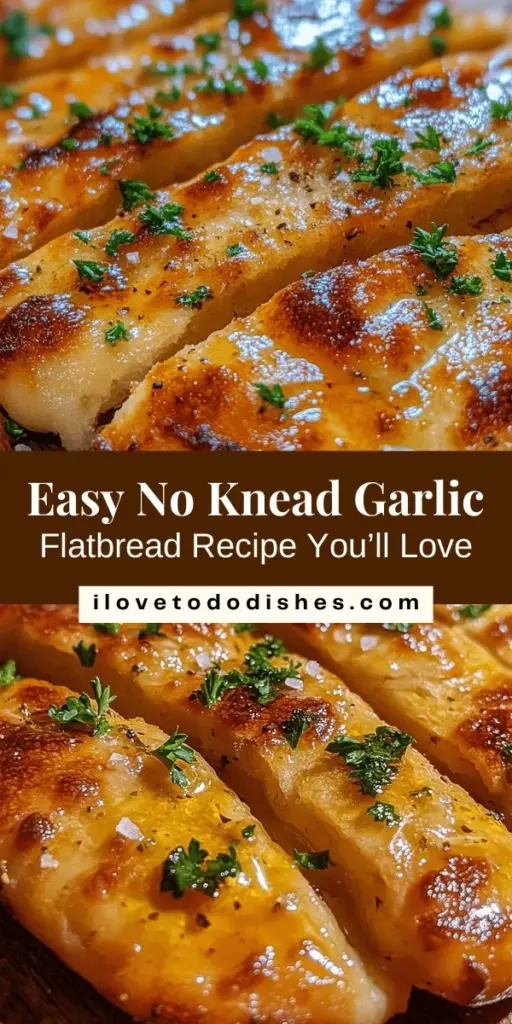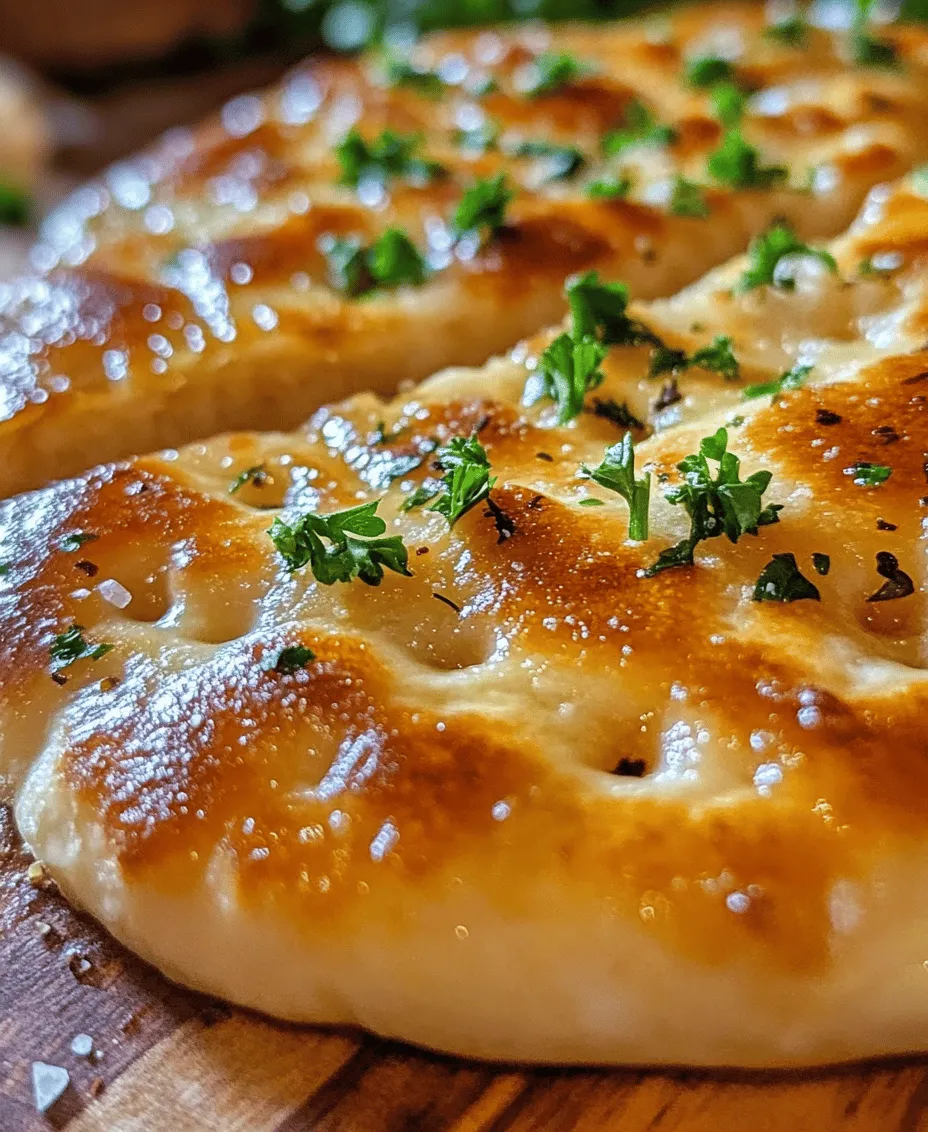Introduction to No Knead Garlic Flatbread
Flatbreads have captivated taste buds across various cultures for centuries, serving as a staple food in regions from the Middle East to India, and even in Mediterranean cuisines. Their versatility allows them to be enjoyed in countless ways: as a side to hearty stews, a base for wraps, or simply as a delightful snack on their own. Among the myriad varieties of flatbreads, garlic flatbread stands out for its aromatic flavor and comforting texture, making it an instant favorite for many.
The concept of no-knead bread making has revolutionized home baking, making it accessible to even the most novice of cooks. This technique requires minimal effort and time, allowing anyone to create delicious homemade bread without the need for extensive kneading. The beauty of no-knead breads lies in their forgiving nature; as long as you can combine a few basic ingredients, you can achieve a soft and flavorful flatbread that pairs perfectly with meals or can be savored alone.
Garlic flatbread, in particular, brings a robust flavor profile to the table. Infused with the aromatic essence of garlic and complemented by herbs, this bread becomes a delightful addition to any meal. Its soft, pillowy texture and golden-brown crust make it a beloved choice for family dinners, picnics, or casual gatherings. Whether served alongside a rich curry, a fresh salad, or enjoyed straight from the oven with a slather of butter, garlic flatbread is sure to impress.
Understanding the Ingredients
To create the perfect no-knead garlic flatbread, understanding each ingredient and its role in the recipe is crucial. Let’s delve into the components that come together to make this delectable flatbread.
All-Purpose Flour
All-purpose flour serves as the foundation of your flatbread, providing the necessary structure and texture. Its moderate protein content creates a balance between chewiness and tenderness, resulting in a soft yet sturdy bread. The versatility of all-purpose flour makes it an ideal choice for countless baking projects, including this flatbread.
Instant Yeast
Yeast is fundamental in the fermentation process, allowing the dough to rise and develop its unique flavor. Instant yeast is particularly advantageous because it activates quickly and does not require proofing, which simplifies the preparation process. By incorporating instant yeast into the recipe, you can expect a light and airy texture in your finished flatbread.
Salt
Salt plays a dual role in bread-making. Not only does it enhance the overall flavor of the flatbread, but it also contributes to the development of the dough. Salt strengthens the gluten structure, allowing for better texture and rise. It’s important to use the right amount of salt, as too little can result in bland bread, while too much can inhibit yeast activity.
Sugar
Sugar might seem like an optional ingredient, but it plays a key role in activating the yeast and balancing the flavors in your flatbread. When mixed with warm water, sugar provides a quick source of nourishment for the yeast, helping it to thrive and create the desired rise. Additionally, sugar adds a hint of sweetness that complements the savory notes of garlic and herbs.
Warm Water
Warm water is essential for yeast activation, providing the ideal environment for the yeast to flourish. The temperature of the water should be between 100°F to 110°F (38°C to 43°C) to optimize yeast activity without killing it. This step is crucial for achieving the light and fluffy texture characteristic of no-knead breads.
Garlic
Garlic is the star ingredient in this flatbread, offering a robust flavor that elevates the entire dish. Beyond its culinary qualities, garlic is also renowned for its numerous health benefits, including its potential to boost immunity and improve heart health. Using fresh garlic in the recipe ensures an intense flavor that permeates the bread.
Olive Oil
Olive oil not only contributes moisture to the flatbread but also enhances its flavor profile. The richness of olive oil helps to create a tender crumb while adding a subtle fruity note that pairs beautifully with garlic and herbs. Additionally, a light drizzle of olive oil before baking can promote a golden, crispy crust.
Dried Oregano and Herbs
Dried oregano and other herbs bring aromatic flavors to the flatbread, infusing it with a delightful fragrance. The earthy and slightly peppery notes of oregano complement the garlic, creating a well-rounded taste. Feel free to experiment with other dried herbs such as basil, thyme, or rosemary to personalize your flatbread’s flavor.
Fresh Parsley
Fresh parsley adds a vibrant touch and a burst of flavor as a garnish. Its bright green color not only enhances the visual appeal of the flatbread but also provides a fresh contrast to the richness of the garlic and olive oil. Parsley is also a source of vitamins and nutrients, making it a healthy addition to your dish.
Sea Salt
The finishing touch of sea salt elevates the flavor of the flatbread. Sprinkling a few flakes of sea salt on top just before serving enhances the overall taste and provides a satisfying crunch. This simple step can make a significant difference in the final result, ensuring that each bite is bursting with flavor.
The No Knead Technique Explained
The no-knead technique is a game-changer for home bakers, particularly those intimidated by traditional bread-making methods. This approach relies on a long fermentation time to develop flavor and texture, eliminating the need for intensive kneading. The process works on the principle that allowing the dough to rest and rise over an extended period allows the gluten to develop naturally, resulting in a soft, airy bread with minimal effort.
One of the key advantages of the no-knead method is its simplicity. Rather than spending time kneading the dough to develop gluten, you can simply mix the ingredients together and let them work their magic over time. This hands-off approach makes it easy to fit bread-making into a busy schedule, as the dough can be prepared in advance and left to rise while you go about your day.
The science behind this technique centers on the fermentation process. As the yeast consumes the sugars in the dough, it produces carbon dioxide gas, which creates air pockets and causes the dough to rise. The longer the dough ferments, the more complex the flavors become, resulting in a flatbread that is not only delicious but also boasts a character that can only be achieved through time and patience.
Step-by-Step Instructions for Making No Knead Garlic Flatbread
Now that we’ve familiarized ourselves with the ingredients and the no-knead technique, let’s dive into the step-by-step process for making no-knead garlic flatbread. The first step involves mixing the dry ingredients, a crucial phase in setting the foundation for your delicious bread.
Mixing the Dry Ingredients
To start, gather the all-purpose flour, instant yeast, salt, sugar, and dried oregano in a large mixing bowl. It’s important to measure these ingredients accurately to ensure the best results. Using a whisk or a fork, gently combine the dry ingredients until they are evenly distributed. This step not only helps to ensure that the yeast is evenly dispersed throughout the flour but also prevents any clumping of the salt and sugar.
Pay attention to the texture of the flour as you mix. It should appear light and fluffy, without any lumps. This ensures that your flatbread will have a consistent texture and rise evenly during baking. Once the dry ingredients are thoroughly mixed, you’re ready to move on to the next steps in creating your no-knead garlic flatbread.
Stay tuned for the continuation of this recipe, where we will explore the mixing of wet ingredients, the fermentation process, and the baking techniques that will yield the perfect flatbread.
Combining the Wet Ingredients
To achieve a truly flavorful No Knead Garlic Flatbread, it is essential to combine the wet ingredients properly. Start by finely mincing or crushing your garlic cloves to release their aromatic oils and potent flavor. Once you have the garlic ready, mix it with the olive oil in a small bowl. This step not only helps to infuse the oil with the garlic flavor but also ensures that the garlic is evenly distributed throughout the batter.
When you incorporate the garlic oil mixture into your batter, do so carefully. Pour the oil mixture into the flour and water mixture gradually, stirring gently with a spatula or wooden spoon. Make sure to scrape the sides and bottom of the bowl to incorporate all the flour. The goal is to achieve a homogeneous mixture where the garlic and oil are evenly spread throughout the dough.
Creating the Batter
The batter for your No Knead Garlic Flatbread should have a specific consistency that is both thick and pourable. As you stir, you should look for visual cues indicating that the batter is ready. It should resemble a thick pancake batter—smooth, with no dry pockets of flour remaining. If you notice that the batter is too thick, you can add a tablespoon of water at a time until you reach the desired consistency.
Another critical aspect is to ensure that the batter is not overmixed. Overmixing can lead to a dense flatbread rather than the light and airy texture that we desire. Once your batter is well combined, cover the bowl with plastic wrap or a clean kitchen towel, allowing it to rest for a few moments while you prepare for the next step.
Letting the Dough Rise
Fermentation is a crucial part of the flatbread-making process, as it allows the dough to develop flavor and structure. After combining your ingredients, place the covered bowl in a warm environment—ideally around 75°F to 80°F (24°C to 27°C). This could be near a sunny window or in a slightly warmed oven (make sure to turn it off before placing the dough inside).
Let the batter rest for at least 1 to 2 hours. During this time, you will notice that the batter has risen and become bubbly, indicating that the yeast is actively fermenting. This rest period not only enhances the flavor of your flatbread but also contributes to its airy texture.
Cooking the Flatbreads
Cooking your No Knead Garlic Flatbread to perfection requires the right equipment and techniques. A cast-iron skillet or non-stick frying pan works best for this recipe. Ensure that the skillet is clean and dry before use to prevent sticking.
Preheating the Skillet
Preheating your skillet is essential for even cooking. Turn your burner to medium-high heat and allow the skillet to heat up for about 5 minutes. You can test the heat by sprinkling a few drops of water into the pan; if they sizzle and evaporate immediately, it is ready for the batter.
Flipping Techniques
When it comes time to pour the batter into the skillet, do so carefully to avoid splashing. Pour a ladleful of batter into the hot skillet and let it spread out naturally. Cook for about 2-3 minutes until bubbles form on the surface and the edges begin to look set.
To flip the flatbread without tearing it, use a spatula to gently lift the edges before sliding it underneath. It’s essential to use a gentle motion, as overly aggressive flipping can cause the flatbread to break apart. Cook the second side for another 2-3 minutes until golden brown.
Flavor Variations and Customizations
One of the joys of making No Knead Garlic Flatbread is its versatility. You can easily customize the flavor profile to suit your preferences.
– Alternative Herbs and Spices: Experiment with adding fresh or dried herbs such as rosemary or thyme. These herbs complement garlic beautifully and add depth to the flavor. For a spicy kick, consider incorporating chili flakes or smoked paprika into the batter.
– Toppings or Fillings: Elevate your flatbread by adding toppings or fillings. Cheese is a fantastic addition—try crumbled feta, shredded mozzarella, or even goat cheese. Sun-dried tomatoes or olives can also bring a Mediterranean flair to your flatbread.
– Different Types of Flour: For unique textures and flavors, consider using different flours. Whole wheat flour can make for a heartier flatbread, while spelt flour offers a nutty flavor. Mixing various flours can create a custom blend that suits your taste.
Serving Suggestions for No Knead Garlic Flatbread
The No Knead Garlic Flatbread is a versatile addition to any meal. Here are some serving ideas to inspire you:
– Pairing Ideas: This flatbread pairs wonderfully with soups and stews, providing a perfect vehicle for soaking up flavorful broths. It also complements salads and dips like hummus or tzatziki, making it an excellent appetizer or snack.
– Meal Incorporation: Use the flatbread as a wrap for your favorite fillings, such as grilled vegetables, meats, or even falafel for a delightful Mediterranean-inspired meal. Additionally, you can transform it into mini pizzas by adding sauce and toppings before baking.
– Serving Fresh and Warm: For the best experience, serve your flatbread warm and fresh off the skillet. If you need to prepare it in advance, consider wrapping it in a clean kitchen towel to keep it warm until serving.
Nutritional Information and Health Benefits
Understanding the nutritional profile of your No Knead Garlic Flatbread can enhance your appreciation for this delicious recipe. Each flatbread is primarily made from flour, water, garlic, and olive oil, contributing to its nutritional value.
– Nutritional Overview: A single piece of flatbread typically contains carbohydrates for energy, moderate protein from the flour, and fats from the olive oil. The garlic adds minimal calories while packing a punch in terms of flavor and health benefits.
– Health Benefits: Garlic is renowned for its numerous health benefits, including its ability to boost the immune system, lower blood pressure, and provide antioxidant properties. Olive oil, especially extra virgin, is rich in monounsaturated fats and has anti-inflammatory benefits.
– Moderation: While No Knead Garlic Flatbread is a delicious treat, it’s essential to enjoy it as part of a balanced diet. Pair it with a variety of nutrient-dense foods to create a wholesome meal.
Conclusion: Embracing the Simplicity of No Knead Garlic Flatbread
In summary, making No Knead Garlic Flatbread is a simple yet rewarding kitchen endeavor. The ease of preparation, combined with the exceptional flavor and versatility of this flatbread, makes it a must-try for home cooks of all levels.
Don’t hesitate to experiment with different flavors, herbs, and ingredients to make this recipe your own. Enjoy the process of creating homemade bread, and relish the satisfaction of sharing warm, fragrant flatbread with family and friends. Whether you serve it as a side dish, a wrap, or a base for a delightful appetizer, this No Knead Garlic Flatbread will surely impress and satisfy. Embrace the joy of homemade bread-making and savor every delicious bite!



